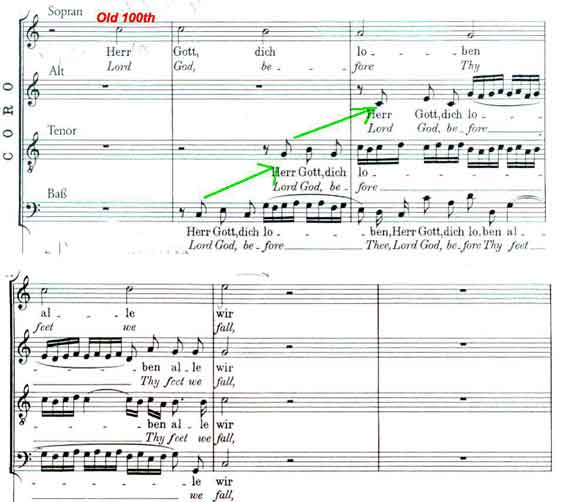Cantata 130 is one of many in the 1723-1724 cycle of Leipzig cantatas, the second of Bach’s Leipzig cantata cycles. It was written for the feast of St. Michael (sometimes called “Michaelmas”). Four of Bach’s cantatas written for this feast survive to the present day. The text comes from an anonymous author, and is based on Paul Eber’s Hymn “Herr Gott, dich loben alle wir” (1554). The chorale tune which serves as a basis for this chorale cantata comes from “Or sus, serviteurs de Siegneur” (1551), which modern listeners will recognize as the “Old 100th”) (“Praise God from Whom All Blessings Flow”). The tune is the basis for the first and last movements of this cantata.
The cantata begins joyously, with a chorale fantasia in a lively tempo, with three trumpets, timpani, three oboes, and strings in the orchestra. The texture is extremely complicated, with descending arpeggiated figures in the oboes against ascending arpeggios in the trumpets. The continuo, meanwhile, is full and active. Bach’s orchestral introduction truly creates a regal sense, setting the tone for the chorus, which praises God for the angels who float around God’s throne. St. Michael, as one of the archangels, is among the greatest of those for whom thanks is given.
There are four choral entrances, each marking one phrase of the hymn tune. In the first, the choir enters, building a complicated texture around the chorale tune, which appears, as is customary, in the sopranos. The lower three voices enter – bass, then tenor, then alto – in imitative fashion, adopting and adapting the sixteenth note figures heard throughout the orchestral introduction. (For the sake of simplicity, the supporting orchestral parts have been eliminated from the example below.)

The second entrance is timed in unison, though elaborated with numerous sixteenth notes. The third again employs an imitative approach, with voices entering in the opposite fashion as in the first entrance (alto, tenor, bass). The fourth and final entrance combines ideas from the previous three: two parts enter first (alto and tenor), with the bass employing imitation shortly thereafter; sixteenth notes again mark the individual statement. This final choral statement is elongated, with four measures added to strengthen the cadence.
The recitative that follows serves as a good textual transition from the brilliance and splendor of the opening movement to Michael’s battle against Satan’s evils, the focus of the bass aria (movement three). Clearly, Bach’s musical setting in the aria indicates Michael’s triumph. The trumpets and timpani return, as does the C major key of the opening movement. Rising triplet arpeggios connect this movement musically with the first, while once again helping to set a celebratory tone. Robertson indicates that timpani may represent “the scheming of the Evil one”. Nicholas Anderson sees the timpani as helping to portray the confrontation between Satan and the angels, in a manner worthy of Milton. I am not convinced of this when I listen. Since timpani are often linked with trumpets in Bach’s work, I am not surprised by the timpani’s presence. Admittedly, the timpani is more of a presence than we might be accustomed to. But the same rapid rhythmic figures which initially are heard in the timpani eventually make their way into the vocal bass line.


If we believe Robertson and Anderson…is this making the battle between the good and evil, between Satan and Michael, the real, more present? Is it telling us that the battle rages on in modern day life, in the hearts of modern man?
An unusual recitative forms the bridge to the final aria for tenor. This is an accompanied recitative, with all the strings accompanying, rather than just the continuo. Furthermore, the vocal line is carried by two voices, soprano and tenor, rather than one. It is, as a result, more melodic and affective than the simple recitatives which we hear so often in Bach’s cantatas and other large vocal works. The music moves from e minor to G major, representing both the night and day – the darkness and light – referred to in the text.
Little and Jenne identify the fifth movement as a gavotte, though it is of course not titled as such. (No work intended to be performed in church would have had a clearly secular title, especially something associated with courtly dances!) Indeed, it is a moderate tempo movement beginning mid-way through the measure, as is typical of gavottes. The aria is a da capo aria, but it is also a trio sonata in terms of texture, with a solo flute, solo tenor, and continuo sounding throughout. The solo flute helps to keep the texture light. The use of two high melody parts – flute and tenor – helps reflect the reach up to heaven, as we hear in the text. The flute part is very demanding, and implies that Bach must have had an outstanding flutist at his disposal.
The final movement sets two verses of the hymn. The tune is transformed from its usual common time to triple meter. Instead of the orchestra doubling the vocal parts exactly, as is the norm in these final chorale movements, Bach includes some slight alterations to the continuo part (compared with the choral bass line), and includes an ornamental trumpet line at each cadence.


































